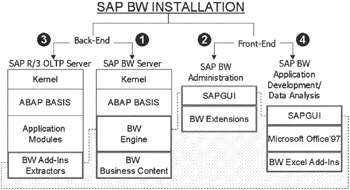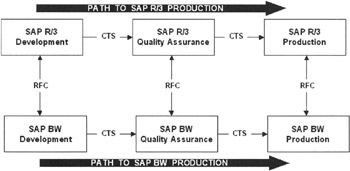Getting Ready for SAP BW Software Installation
One major benefit of ERP data warehousing is that OLTP and data warehouse environments use the same infrastructure. Because SAP BW is built on top of SAP R/3 BASIS technology, the core software-installation process is very similar to installing an SAP R/3 instance. The assumption here is that you have implemented SAP R/3 and are planning to install SAP BW. Your BASIS support team is fully trained in installing SAP R/3. This chapter describes the process for setting up SAP BW, not installing the SAP R/3 kernel and BASIS layer. For information on how to install SAP R/3, see the SAP R/3 installation guides that are packaged with the software. Also refer to Basis Administration for SAP by Robert E. Parkinson, et.al., published by PrimaTech.
| Note | You can implement SAP BW without SAP R/3 as a data source. Here you are working with flat files or third-party tools that are certified to load data in SAP BW. But you still need trained individuals on your teams who are fluent in SAP R/3 architecture, BASIS, and Application Link Enabling (ALE) technology. |
Assuming that you have the core SAP R/3 component installed, configuring SAP BW consists of the following four steps:
-
Configure the SAP BW database and application server.
-
Configure the SAP BW administrator's workstation.
-
Install SAP BW extractors in SAP R/3 OLTP instances.
-
Install frontend components for end-user reporting and analysis.
Figure 6-1 illustrates these four steps. This chapter covers only those items related to SAP BW as marked by the dotted gray area in Figure 6-1.

Figure 6-1: SAP BW Installation Steps-Backend and Frontend. The Shaded Area Represents the SAP BW Specific Component Installation.
Like any SAP R/3 implementation, SAP BW supports several platforms and databases. Selecting a platform (hardware and software) for SAP BW mostly depends on your current SAP R/3 platform. Because the SAP R/3 operational staff is already trained on a specific SAP R/3 environment, you may use the same hardware and database engine for SAP BW. Often, an OLTP instance does not require Very Large Memory (VLM)/64bit processor support. However, due to large data volumes in a data warehouse per data request/transaction, complex and compute-intense data analysis requirements, you may consider a different hardware vendor than your OLTP platform that best suits your SAP BW usage needs.
After deciding on the platform, sizing questions come to mind, such as the following:
-
How big should my machine be?
-
How many CPUs should that machine have?
-
How much memory do I need?
-
How much storage do I need?
-
What are the network requirements?
The answers to such questions are still evolving. SAP has proposed basic SAP BW configurations; Table 5-1 in Chapter 5 lists these. These recommendations are based on a few initial SAP BW customers (SAP BW 1.2B versions). However, to provide realistic configurations for SAP BW on supported platforms, SAP is working with hardware vendors such as Compaq, Hewlett-Packard, IBM, and Sun to conduct SAP BW benchmarks and provide realistic sizing information. At the time of this writing, only IBM had published SAP BW 1.2B benchmarks using DB2 database on IBM hardware. Check SAP and the hardware vendor's Web sites for the latest SAP BW configurations.
The SAP BW implementation landscape is another factor to consider when sizing SAP BW. SAP recommends a three-phase rollout strategy for SAP BW that includes the following individual systems, as shown in Figure 6-2.

Figure 6-2: SAP BW System Landscape-Path to Production.
-
Pilot/Development System. This system is used to do initial SAP BW assessment and then extend to develop custom analytical applications. Developers mostly use this system.
-
Test System. The test system is used to test and verify data access, reporting, and analytical applications to qualify end-user acceptance tests before rollout onto the production system. The test system can also be used to do stress testing and fine-tuning of data objects for optimum performance. Quality assurance and development teams have access to this system.
-
Production System. The production system is the "live" SAP BW implementation. The objects in the production system are transported from the test system and connected to production SAP R/3 production instances to meet end-user data analysis needs.
Collectively, these three classes of systems are known as SAP BW System Landscape. The Correction and Transport Organizer (CTO) is used to move objects between these systems: development to test and test to production.
In a typical SAP R/3 implementation, the system landscape is relatively simple. However, for SAP BW, the path to production is complex. Here you are moving objects between SAP BW systems and at the same time, the corresponding SAP BW-related objects in SAP R/3 are moved between SAP R/3 OLTP systems. It is important to note that the individual SAP R/3 system is connected to the corresponding SAP BW system via Remote Function Calls (RFC) instead of Correction and Transport System (CTS). The reason is that communication between SAP R/3 and SAP BW is from a metadata and data perspective, and not at an object (program, transaction, or table) level.
The order in which objects are transported between SAP BW and SAP R/3 systems is discussed in Chapter 12, "SAP BW-Defining Custom InfoCubes."
Database size, as with any other data warehouse, grows rapidly. Often, the actual size of a database is almost two or three times the size of the actual transaction data received from the transaction systems. It is expected that master data will change, but the growth of master data in SAP BW is not that significant after initial loads. Plan for plenty of storage space, at least 50 percent more than your estimate, when configuring an SAP BW system.
SAP BW, like any other data warehouse, needs to handle large data volumes-to load new data or to read data from a database for end-user queries. Therefore, SAP BW requires a fast disk I/O subsystem. This means large bandwidth, which is achieved by spreading the database across a large number of array controllers. The number of I/O controllers is derived from the estimated bandwidth required by the workload, typically 10MB/sec for each CPU. For example, a system with eight CPUs should have enough I/O controllers to support 80MB/sec bandwidth. Adding more memory and faster processors will not necessarily improve SAP BW performance if disk I/O subsystems are causing the problem-I/O bandwidth that is not large enough.
Based on your SAP BW landscape, the first step is to set up a Pilot/Development SAP BW and associated SAP R/3 system for your project.
| Team-Fly |
EAN: 2147483647
Pages: 174
- Chapter I e-Search: A Conceptual Framework of Online Consumer Behavior
- Chapter V Consumer Complaint Behavior in the Online Environment
- Chapter VII Objective and Perceived Complexity and Their Impacts on Internet Communication
- Chapter XVII Internet Markets and E-Loyalty
- Chapter XVIII Web Systems Design, Litigation, and Online Consumer Behavior